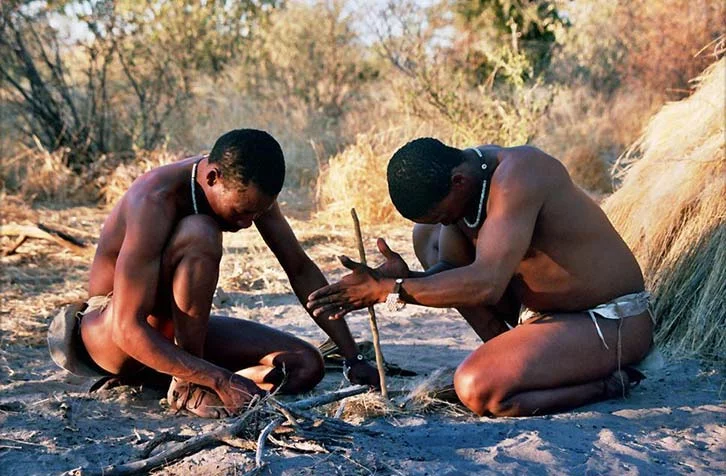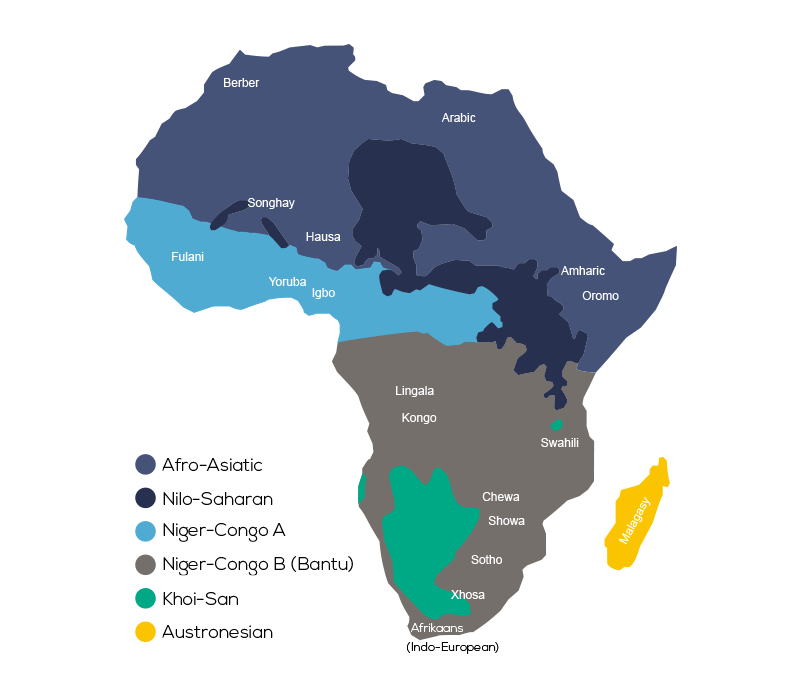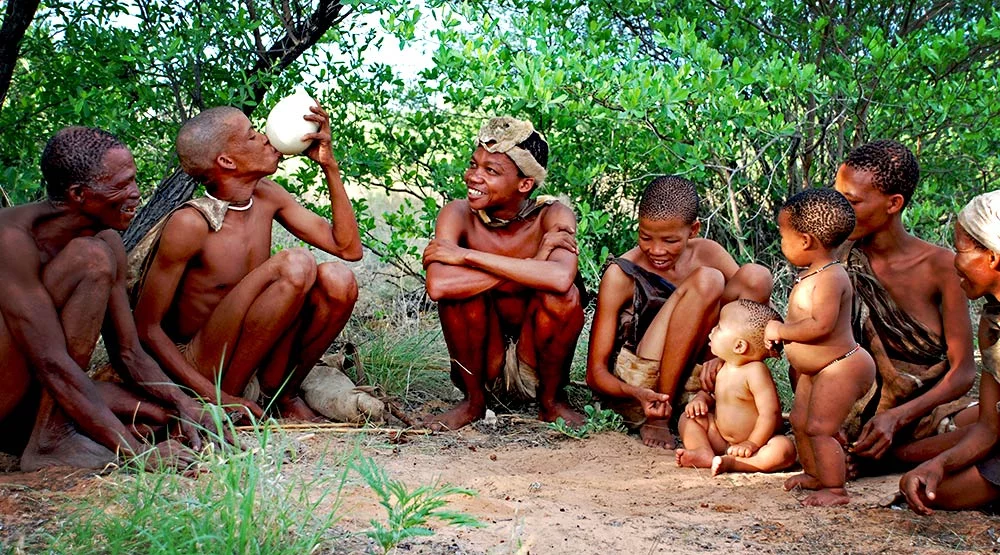Usually, a click is a sound produced to express things such as disapproval (“tsk”), imitate a knock, or to encourage an animal. But did you know there are 27 languages in Africa that use clicks in words? Also knowns as, clicking languages.
No idea what a clicking language is? Watch this video of Miriam Makeba’s sing “Qongqothwane” in Xhosa, also known as “The Click Song”.
Khoisan Languages
These famous click sounds are found in Khoisan languages (alternative names include Khoesaan or Khoesan). The name Khoisan is a compound word formed with the native words khoi “person” and san “forager”, meaning ‘persons who forage in the bush” or “bushmen”. Thus, a more correct spelling is Khoesaan.
This distinctive linguistic characteristic was adopted by a number of neighbouring Bantu languages, such as Xhosa and Zulu in South Africa. Every single click in Miriam Makeba’s “Click Song,” which is in Xhosa, is a sound that was borrowed from a neighbouring language and swapped into existing words — and not all that long ago, either.

Isewell [CC BY-SA 2.5], via Wikimedia Commons
What I love most about uTalk is that you can jump around their extensive library of topics and choose what you want to learn, when you want, and at your own pace. Because I believe in uTalk so much, I reached out to them and we’ve teamed up to offer you an exclusive 30% OFF reader discount across all of uTalk’s 140 languages! This offer isn’t available anywhere else! Click here to claim your exclusive 30% discount.
History
The Khoisan language family is the smallest of the language families of Africa. The name Khoisan derives from the name of the Khoikhoi (“people people” or “real people”) group of South Africa and the San (“Bushmen”) group of Namibia.
Archaeological evidence suggests that the Khoisan people appeared in southern Africa 60,000 years ago. Making the Khoisan languages amongst the most ancient of all human tongues.
The Khoikhoi were once called Hottentots by Europeans. This term, now considered derogatory, means “stutterer” in Dutch. However, the Dutch used the word “stotteraar” to more specifically describe the clicking sounds used in the Khoisan languages. The word lives on, however, in the names of several African animal and plant species, such as the Hottentot Fig or Carpobrotus.
Distribution and Speakers
Today, the Khoisan languages are spoken only in southwestern Africa, in the region around the Kalahari Desert extending from Angola to South Africa, and in one small area of Tanzania.
Ethnologue lists 27 Khoisan languages which are spoken by half a million people or less. These are divided into North, Central and South Khoisan groups belonging to southern Africa, plus two Tanzanian isolates, Sandawe and Hadza (Hatsa), which possess a few words, affixes, and particles that justify the assumption of a distant relationship with Khoisan.
North Khoisan is spoken by hunter-gatherers mainly in Namibia. Central Khoisan, the largest group, includes Nama (Khoekhoe, Khoekhoegowab) and Haiom (Saan) spoken in Namibia, and smaller languages spoken in the Kalahari desert of Botswana. South Khoisan includes a couple of endangered and several extinct languages of the Kalahari Desert.

By Mark Dingemanse [GFDL, CC-BY-SA-3.0 or CC BY 2.5], via Wikimedia Commons
How Many People Speahk Khoisan?
The number of Khoisan speakers has declined drastically in the last three centuries due to European colonisation, demographic pressures and changing lifestyles. Some languages have become extinct and others are endangered.
Nama, the largest Khoisan language, is officially recognized in Namibia and is taught at universities. The other Khoisan languages are unrecognized and marginalized, especially in South Africa. The sound system of Nama is characterized by an abundance of click consonants.
Of all the Khoisan languages, only Nama enjoys official recognition. It is a national of Namibia, along with English and a number of other regional languages. Nama is used in education and in the media.
Other languages have little more than 1,000 speakers while several are known to have become extinct. Unfortunately, many of these languages have left behind no written records, so their loss is permanent.
One of the main reasons for the decline is that bilingual Khoisan speakers shift to the dominant language of the area and stop teaching the language to their children. There are some exceptions, for instance, the Sandawe language in Tanzania whose speakers have maintained a relatively stable linguistic community.
Khosian Writing System
Most of the languages are unwritten, but Nama and Naro have Latin-based orthographies. Nama, in particular, has a long tradition of literacy.
Origin of Clicks
The origin of clicks remains a mystery. Some scholars speculate that they might represent an earlier stage in the evolution of human language. According to this hypothesis, clicks might have originally served as onomatopoetic imitations of naturally occurring sounds. However, there is no scientific proof to support this hypothesis since all languages use sound symbolism to a lesser or greater extent.
Khoisan Phonology
The Khoisan languages share some similarities in their extremely complex sound systems. All click and most non-click consonants appear at the beginning of words and are followed by a vowel. Only a few consonants, such as /b/, /m/, /n/, /r/, and /l/ can appear between vowels, and even fewer can appear at the end of words.
Clicks are ingressive consonantal stops produced by an intake of air followed by a sudden withdrawal of the tongue from the soft palate, front teeth, or back teeth and hard palate. The basic clicks are four: dental (|), alveolar (!), palatal (ǂ), and lateral (ǁ). Southern Khoisan has a fifth click, the bilabial ʘ.
The Tanzanian languages, Sandawe and Hadza, use only three basic clicks: |, ǁ, and !. Each click can combine with a number of accompanying articulations such as voicing, nasality, aspiration, and ejection producing a potentially large number of consonantal sounds: Nama has 20, Gwi 52, Ju’hoan 55 and Xóo 83.
Besides clicks, Khoisan languages have non-click consonants, giving rise to very complex consonantal systems which are amongst the largest in the world. As a balance to consonant complexity, strict rules restrict clicks and most of the non-clicks to the beginning of a word being followed always by a vowel.
How to Produce Clicks in Khoisan
Clicks are stops produced with two points of contact in the mouth: one forward and one in the back. The pocket of air produced by the resulting enclosure is rarefied by the sucking action of the tongue. The release of the forward closure results in a pop-like sound.
Click consonants can be modified in a variety of ways. For instance, they can be aspirated, nasalised and glottalised. The Khoisan languages differ in the number of such modifications from a low of 20 in Nama to a high of 83 in Kxoe. Southern Khoisan languages have a very high ratio of words containing clicks as compared to those that do not contain them.
There are several places of articulation at which click consonants occur, as shown in the table below.
| Types of clicks | Symbol | Description |
|---|---|---|
| Bilabial | ʘ | A bilabial click is a pop made by bringing the lips together and releasing them, just like the sound of a kiss. |
| Dental | ǀ | A dental click sounds like ‘tsk, tsk! ‘ and is made by putting the tongue just behind the front teeth. |
| (Post)alveolar | ! | An alveolar click sounds like the popping of a cork made by putting the tongue just behind the ridge in back of the front teeth. |
| Lateral | ǁ | An alveolar click sounds like the popping of a cork made by putting the tongue just behind the ridge in back of the front teeth. |
| Palatal | ǂ | A palatal click is a sharp pop made by drawing the tongue down quickly from the roof of the mouth. |
Going to South Africa? Don’t miss these
- Survival Afrikaans Travel Phrase Guide with Pronunciation
- Top 20 Bucket List Things to Do in Cape Town and Beyond!
- 25 Hilarious Afrikaans Idioms That Should Exist in English
- 20 Beautiful African Words in ‘The Lion King’ That’ll Make You Smile
Sources
Languages Gulper / Khoisan Peoples / About World Languages / Wikipedia / The Week
Over to you!
Can you reproduce these click types? Do you think English would be more interesting with similar click sounds?
Let me know using the comments section below or join me on social media to start a conversation.
Thanks for reading and I hope you enjoyed this post.
Like what you see? Subscribe using the form below to have all of my posts delivered directly to your email.

